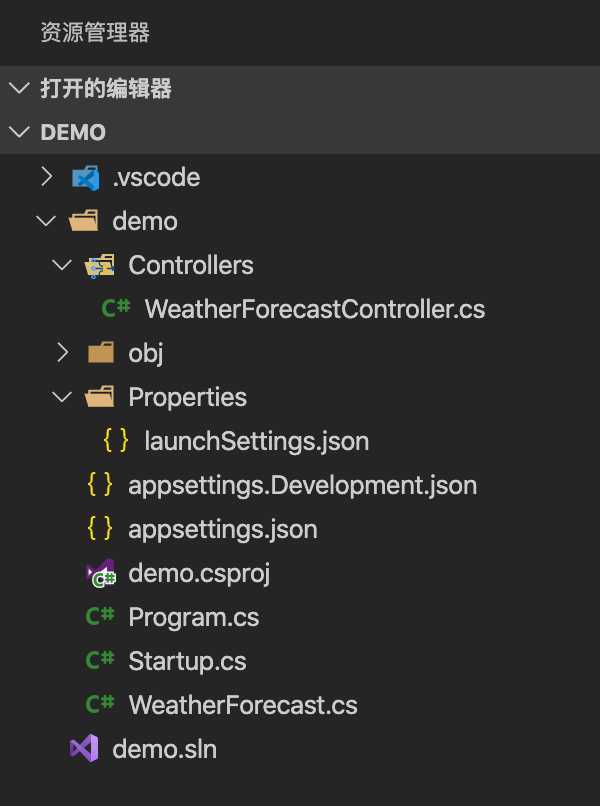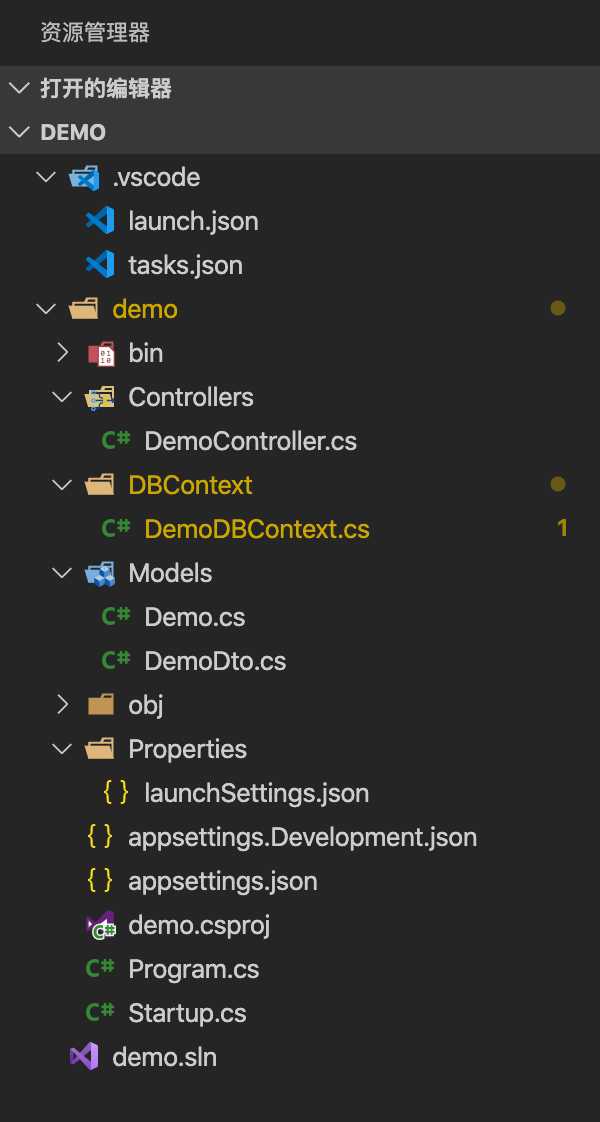MacOS + VS Code搭建支持10w+用户的生产环境
Posted leo_wl
tags:
篇首语:本文由小常识网(cha138.com)小编为大家整理,主要介绍了MacOS + VS Code搭建支持10w+用户的生产环境相关的知识,希望对你有一定的参考价值。
架构实践
前边用了三篇文章,详细介绍了这个架构的各个部分的选择以及安装。
这篇文章,我会用一个Demo项目,从开发到部署,包括MongoDB数据的访问。用这种方式过一遍这个架构。
Demo项目,我们用Dotnet Core开发。我们选择最新版的Dotnet Core 3.1做为系统的主框架。
开发环境用MacOS + VS Code,生产环境用云服务器。
第一步:环境检查和搭建
- 先看看各个环境的版本情况
生产环境:
$ cat /proc/version
Linux version 4.9.0-12-amd64 (debian-kernel@lists.debian.org) (gcc version 6.3.0 20170516 (Debian 6.3.0-18+deb9u1) ) #1 SMP Debian 4.9.210-1 (2020-01-20)
$ lsb_release -a
No LSB modules are available.
Distributor ID: Debian
Description: Debian GNU/Linux 9.12 (stretch)
Release: 9.12
Codename: stretch
开发环境:
$ cat /System/Library/CoreServices/SystemVersion.plist
<?xml version="1.0" encoding="UTF-8"?>
<!DOCTYPE plist PUBLIC "-//Apple//DTD PLIST 1.0//EN" "http://www.apple.com/DTDs/PropertyList-1.0.dtd">
<plist version="1.0">
<dict>
<key>ProductBuildVersion</key>
<string>19E287</string>
<key>ProductCopyright</key>
<string>1983-2020 Apple Inc.</string>
<key>ProductName</key>
<string>Mac OS X</string>
<key>ProductUserVisibleVersion</key>
<string>10.15.4</string>
<key>ProductVersion</key>
<string>10.15.4</string>
<key>iosSupportVersion</key>
<string>13.4</string>
</dict>
</plist>
- 安装Dotnet Core 3.1
Dotnet Core官方下载地址:https://aka.ms/dotnet-download
Mac上边是以前装好的,看一下:
$ dotnet --info
.NET Core SDK (reflecting any global.json):
Version: 3.1.201
Commit: b1768b4ae7
Runtime Environment:
OS Name: Mac OS X
OS Version: 10.15
OS Platform: Darwin
RID: osx.10.15-x64
Base Path: /usr/local/share/dotnet/sdk/3.1.201/
Host (useful for support):
Version: 3.1.3
Commit: 4a9f85e9f8
.NET Core SDKs installed:
3.1.201 [/usr/local/share/dotnet/sdk]
.NET Core runtimes installed:
Microsoft.AspNetCore.App 3.1.3 [/usr/local/share/dotnet/shared/Microsoft.AspNetCore.App]
Microsoft.NETCore.App 3.1.3 [/usr/local/share/dotnet/shared/Microsoft.NETCore.App]
生产环境上边,安装步骤如下:
$ wget -O- https://packages.microsoft.com/keys/microsoft.asc | gpg --dearmor > microsoft.asc.gpg
$ sudo mv microsoft.asc.gpg /etc/apt/trusted.gpg.d/
$ wget https://packages.microsoft.com/config/debian/9/prod.list
$ sudo mv prod.list /etc/apt/sources.list.d/microsoft-prod.list
$ sudo chown root:root /etc/apt/trusted.gpg.d/microsoft.asc.gpg
$ sudo chown root:root /etc/apt/sources.list.d/microsoft-prod.list
$ sudo apt-get update
$ sudo apt-get install apt-transport-https
$ sudo apt-get update
$ sudo apt-get install dotnet-sdk-3.1
安装很简单,这要感谢Microsoft,没有误导,也不需要刨坑。
安装完检查一下:
$ dotnet --info
.NET Core SDK (reflecting any global.json):
Version: 3.1.201
Commit: b1768b4ae7
Runtime Environment:
OS Name: debian
OS Version: 9
OS Platform: Linux
RID: debian.9-x64
Base Path: /usr/share/dotnet/sdk/3.1.201/
Host (useful for support):
Version: 3.1.3
Commit: 4a9f85e9f8
.NET Core SDKs installed:
3.1.201 [/usr/share/dotnet/sdk]
.NET Core runtimes installed:
Microsoft.AspNetCore.App 3.1.3 [/usr/share/dotnet/shared/Microsoft.AspNetCore.App]
Microsoft.NETCore.App 3.1.3 [/usr/share/dotnet/shared/Microsoft.NETCore.App]
命令写顺手了,没有分SDK和Runtime,正常应用时,生产环境可以只装Runtime。命令是在最后装Dotnet的一步,用以下命令:
$ sudo apt-get install aspnetcore-runtime-3.1
$ sudo apt-get install dotnet-runtime-3.1
- 生产环境安装MongoDB
详细步骤参见:15分钟从零开始搭建支持10w+用户的生产环境(二)
- 生产环境安装Jexus
详细步骤参见:15分钟从零开始搭建支持10w+用户的生产环境(三)
第二步:开发环境创建Demo项目
- 找个目录,创建解决方案(这一步不是必须,不过我习惯这么做。总要有个解决方案来存放工程):
% dotnet new sln -o demo
The template "Solution File" was created successfully.
这一步完成后,会在当前目录建立一个新目录demo,同时,在demo目录下创建文件demo.sln。
- 在demo目录下,建立工程:
% dotnet new webapi -o demo
The template "ASP.NET Core Web API" was created successfully.
Processing post-creation actions...
Running ‘dotnet restore‘ on demo/demo.csproj...
Restore completed in 16.79 ms for /demo/demo/demo.csproj.
Restore succeeded.
- 把新建的工程加到解决方案中:
% dotnet sln add demo/demo.csproj
Project `demo/demo.csproj` added to the solution.
- 检查一下现在的目录和文件结构:

其中有一个WeatherForecast,包含两个文件:WeatherForecast.cs和WeatherForecastController.cs,是创建工程时自带的演示类。
现在我们运行一下工程。可以用VSC的「运行」,也可以命令行:
% dotnet run
运行Demo工程。
运行后,从浏览器访问:http://localhost:5000/WeatherForecast,会得到一串演示数据。这就是上面这个演示类的效果。
正式项目中,这两个文件要删掉。
到这一步,基础工程就搭好了。
我们要做一个API服务,这个服务里要有几个API,要用到数据库访问。为了测试API,我们需要装个Swagger。当然用Postman也可以,不过我习惯用Swagger。
- 增加Swagger包引用。在demo.csproj的同级目录下运行:
% dotnet add package Swashbuckle.AspNetCore
Swagger装好后,需要在Startup.cs中注册。
在ConfigureServices中加入以下代码:
services.AddSwaggerGen(c =>
{
c.SwaggerDoc("v1", new OpenApiInfo { Title = "My API", Version = "V1" });
});
在Configure中加入以下代码:
app.UseSwagger();
app.UseSwaggerUI(c =>
{
c.SwaggerEndpoint("/swagger/v1/swagger.json", "My API V1");
});
完成后,Startup.cs的代码:
namespace demo
{
public class Startup
{
public Startup(IConfiguration configuration)
{
Configuration = configuration;
}
public IConfiguration Configuration { get; }
// This method gets called by the runtime. Use this method to add services to the container.
public void ConfigureServices(IServiceCollection services)
{
services.AddSwaggerGen(c =>
{
c.SwaggerDoc("v1", new OpenApiInfo { Title = "My API", Version = "V1" });
});
services.AddControllers();
}
// This method gets called by the runtime. Use this method to configure the HTTP request pipeline.
public void Configure(IApplicationBuilder app, IWebHostEnvironment env)
{
if (env.IsDevelopment())
{
app.UseDeveloperExceptionPage();
}
app.UseRouting();
app.UseAuthorization();
app.UseSwagger();
app.UseSwaggerUI(c =>
{
c.SwaggerEndpoint("/swagger/v1/swagger.json", "My API V1");
});
app.UseEndpoints(endpoints =>
{
endpoints.MapControllers();
});
}
}
}
- 增加MongoDB支持
选择一:引用官方包MongoDB.Driver:
% dotnet add package MongoDB.Driver
后面用包提供的SDK进行开发。
选择二:引用包Lib.Core.Mongodb.Helper:
% dotnet add package Lib.Core.Mongodb.Helper
这是我自己维护的一个Helper开源包,对官方的MongoDB.Driver做了一定程序的包装和简化操作。这个包目前在我公司的生产环境中用着。
这个包的开源地址:https://github.com/humornif/Lib.Core.Mongodb.Helper
引用完成后,需要在appsettings.json中增加数据库连接串:
"MongoConnection": "mongodb://localhost:27017/admin?wtimeoutMS=2000"
完成后,appsettings.json的代码如下:
{
"MongoConnection": "mongodb://localhost:27017/admin?wtimeoutMS=2000",
"Logging": {
"LogLevel": {
"Default": "Information",
"Microsoft": "Warning",
"Microsoft.Hosting.Lifetime": "Information"
}
},
"AllowedHosts": "*"
}
- 建立数据库操作类
在工程中创建一个目录Models,在目录下创建一个类文件Demo.cs:
using MongoDB.Bson;
using System;
using System.Collections.Generic;
using System.Linq;
using System.Threading.Tasks;
namespace demo.Models
{
public class Demo
{
public const string DATABASE = "DemoDB";
public const string COLLECTION = "DemoCollection";
public ObjectId _id { get; set; }
public string demo_user_name { get; set; }
public int demo_user_age { get; set; }
}
}
在同一目录下,再创建另一个Dto类DemoDto.cs:
using System;
using System.Collections.Generic;
using System.Linq;
using System.Threading.Tasks;
namespace demo.Models
{
public class DemoDto
{
public string demo_user_name { get; set; }
public int demo_user_age { get; set; }
}
}
在工程中创建另一个目录DBContext,在目录下创建一个对应Demo类的数据库操作类DemoDBContext.cs:
using demo.Models;
using Lib.Core.Mongodb.Helper;
using MongoDB.Bson;
using MongoDB.Driver;
using System;
using System.Collections.Generic;
using System.Linq;
using System.Threading.Tasks;
namespace demo.DBContext
{
public class DemoDBContext : MongoHelper<Demo>
{
//创建数据库操作索引
protected override async Task CreateIndexAsync()
{
}
public DemoDBContext() : base(Demo.DATABASE, Demo.COLLECTION)
{
}
//保存数据到数据库
internal async Task<bool> saveData(DemoDto data)
{
Demo new_item = new Demo()
{
_id = ObjectId.GenerateNewId(),
demo_user_name = data.demo_user_name,
demo_user_age = data.demo_user_age,
};
bool result = await CreateAsync(new_item);
return result;
}
//从数据库查询全部数据
internal async Task<IEnumerable<DemoDto>> getAllData()
{
var fetch_data = await SelectAllAsync();
List<DemoDto> result_list = new List<DemoDto>();
fetch_data.ForEach(p =>
{
DemoDto new_item = new DemoDto()
{
demo_user_name = p.demo_user_name,
demo_user_age = p.demo_user_age,
};
result_list.Add(new_item);
});
return result_list;
}
}
}
这三个类的关系是:
- Demo类是数据类,对应MongoDB数据库中保存的数据。Demo.DATABASE是数据库中的DB名称,Demo.COLLECTION是数据库中的Collection名称。这个类决定数据在数据库中的保存位置和保存内容。
- DemoDta是Dta的映射类,在正式使用时,可以用AutoMap与Demo关联。在这个Demo中,我用它来做数据从前端到API的传递。
- DemoDBContext是对Demo结构数据的数据库操作。这个类派生自Lib.Core.MongoDB.Helper中的父类MongoHelper。所有对Demo数据的操作全在这个类中进行。
- 创建API控制器
在Controller目录中,创建DemoController.cs:
using demo.DBContext;
using demo.Models;
using Microsoft.AspNetCore.Mvc;
using System;
using System.Collections.Generic;
using System.Linq;
using System.Threading.Tasks;
namespace demo.Controllers
{
[ApiController]
[Route("[controller]")]
public class DemoController : ControllerBase
{
[HttpPost]
[Route("savedata")]
public ActionResult<string> saveData(DemoDto data)
{
DemoDBContext dc = new DemoDBContext();
bool result = dc.saveData(data).GetAwaiter().GetResult();
if(result)
return "OK";
return "ERROR";
}
[HttpGet]
[Route("getdata")]
public IEnumerable<DemoDto> getData()
{
DemoDBContext dc = new DemoDBContext();
return dc.getAllData().GetAwaiter().GetResult();
}
}
}
在这个控制器中,做了两个API:
- 基于POST的savedata,用来写入数据到数据库;
- 基于GET的getdata,用来从数据库读取数据到前端。
数据库的操作,调用了DemoDBContext中写好的两个数据库操作方法。
数据库操作的完整方法,可以参见https://github.com/humornif/Lib.Core.Mongodb.Helper的详细说明。
- 检查一下现在的工程目录结构:

- 测试运行
在VSC中点击运行,或者命令行输入:
% dotnet run
等程序加载完成,可以访问http://localhost:5000/swagger,进行访问,并测试两个API。
第三步:发布到生产环境
- 发布应用
前边说了,开发环境是MAC,生产环境是Debian 9 x64,所以会涉及到一个跨平台的发布。
事实上,跨平台发布也很简单。这个应用的目的环境是Linux-64,所以,发布命令是:
% dotnet publish -r linux-x64
发布完成后,系统会显示发布的目录。这个项目,发布目录在demo/bin/Debug/netcoreapp3.1/linux-x64/publish。
- 打包传到服务器,并解包到一个目录。在这个演示中,我解包到了服务器的/var/demo。
- 在服务器Jexus中配置网站。
在/usr/jexus/siteconf中建立网站配置文件demo.80(文件名可以随便起,我的习惯是网站名称+端口号):
######################
# Web Site: DEMO
########################################
port=80
root=/ /var/demo
hosts=* #OR your.com,*.your.com
# User=www-data
# AspNet.Workers=2 # Set the number of asp.net worker processes. Defauit is 1.
# addr=0.0.0.0
# CheckQuery=false
NoLog=true
AppHost={cmd=dotnet demo.dll; root=/var/demo; port=5000}
# NoFile=/index.aspx
# Keep_Alive=false
# UseGZIP=false
# UseHttps=true
# ssl.certificate=/x/xxx.crt #or pem
# ssl.certificatekey=/x/xxx.key
# ssl.protocol=TLSv1.0 TLSv1.1 TLSv1.2
# ssl.ciphers=ECDHE-RSA-AES256-GCM-SHA384:ECDHE:ECDH:AES:HIGH:!NULL:!aNULL:!MD5:!ADH:!RC4:!DH:!DHE
# DenyFrom=192.168.0.233, 192.168.1.*, 192.168.2.0/24
# AllowFrom=192.168.*.*
# DenyDirs=~/cgi, ~/upfiles
# indexes=myindex.aspx
# Deny asp ...
rewrite=^/.+?.(asp|cgi|pl|sh|bash|dll)(?.*|)$ /.deny->$1
rewrite=.*/editor/.+ /.deny->editor
# reproxy=/bbs/ http://192.168.1.112/bbs/
# host.Redirect=abc.com www.abc.com 301
# ResponseHandler.Add=myKey:myValue
ResponseHandler.Add=X-Frame-Options:SAMEORIGIN
# Jexus php fastcgi address is ‘/var/run/jexus/phpsvr‘
#######################################################
# fastcgi.add=php|socket:/var/run/jexus/phpsvr
# php-fpm listen address is ‘127.0.0.1:9000‘
############################################
# fastcgi.add=php|tcp:127.0.0.1:9000
在这个演示项目里,起作用的配置其实就一行:
AppHost={cmd=dotnet demo.dll; root=/var/demo; port=5000}
这一行配置了三件事:
- 应用的运行命令是:dotnet demo.dll
- 应用的运行目录是:/var/demo
- 应用的运行端口是:5000
这样配置就完成了。
接下来,启动网站,在/usr/jexus中运行:
$ sudo ./jws start
网站就启动起来了。
第四步:测试
在本地浏览器中,输入:http://server_ip/swagger,跟在开发环境测试效果完全一样,可以进行数据库的写入和读取操作。
Done !!!
我把上面的代码,传到了Github上,需要了可以拉下来直接使用。
代码地址:https://github.com/humornif/Demo-Code/tree/master/0005/demo
以上是关于MacOS + VS Code搭建支持10w+用户的生产环境的主要内容,如果未能解决你的问题,请参考以下文章